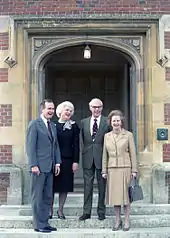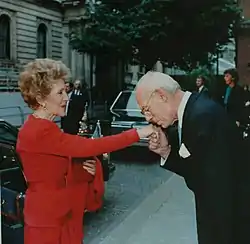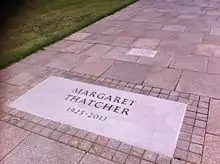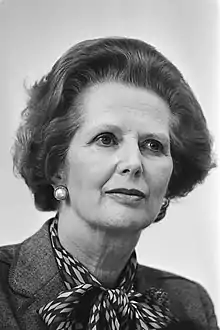Denis Thatcher
Sir Denis Thatcher, 1st Baronet, MBE, TD, CStJ (10 May 1915 – 26 June 2003) was an English businessman. Married to Margaret Thatcher, who served as Prime Minister of the United Kingdom from 1979 to 1990, he was the first male spouse of a British prime minister.
Sir Denis Thatcher | |
|---|---|
.jpg.webp) Thatcher in 1988 | |
| Spouse of the Prime Minister of the United Kingdom | |
| In role 4 May 1979 – 28 November 1990 | |
| Prime Minister | Margaret Thatcher |
| Preceded by | Audrey Callaghan |
| Succeeded by | Norma Major |
| Personal details | |
| Born | 10 May 1915 Lewisham, London, England |
| Died | 26 June 2003 (aged 88) Chelsea, London, England |
| Resting place | Royal Hospital Chelsea 51.489057°N 0.156195°W |
| Nationality | British |
| Political party | Conservative |
| Spouse(s) | |
| Children | |
| Alma mater | Mill Hill School |
| Profession | Business |
| Military service | |
| Branch/service | |
| Years of service | 1938–1965 |
| Rank | Major |
| Unit | |
| Battles/wars | Second World War |
| Awards | |
Granted the Thatcher baronetcy in 1990, Thatcher is the most recent commoner to have been awarded an hereditary title.
Early life
Thatcher was born in Lewisham, south London, as the first child of New Zealand-born British businessman Thomas Herbert "Jack" Thatcher (15 October 1885 – 24 June 1943) and Lilian Kathleen Bird (7 July 1889 – 25 October 1976). At age eight Denis entered a preparatory school as a boarder in Bognor Regis, following which he attended the nonconformist public school, Mill Hill School in north London. At school he excelled at cricket, being a left-handed batsman.
Thatcher left Mill Hill at age 18 to join the family paint and preservatives business, Atlas Preservatives. He also studied accountancy to improve his grasp of business, and in 1935 was appointed works manager. He joined the Territorial Army shortly after the Munich crisis, as he was convinced war was imminent; a view reinforced by a visit he made to Germany with his father's business in 1938.
War record
During the Second World War, Thatcher was commissioned as a second lieutenant into the 34th Searchlight (Queen's Own Royal West Kent Regiment) of the Royal Engineers. He transferred to the Royal Artillery on 1 August 1940.[1] During the war he was promoted to war substantive captain and temporary major. He served throughout the Invasion of Sicily and the Italian Campaign and was twice mentioned in dispatches, and in 1945 was appointed a Member of the Order of the British Empire (MBE). The first mention in dispatches came on 11 January 1945, for service in Italy,[2] and the second on 29 November 1945, again for Italian service.[3]
His MBE was gazetted on 20 September 1945,[4] and was awarded for his efforts in initiating and supporting Operation Goldflake, the transfer of I Canadian Corps from Italy to the north-west European theatre of operations. By this time Thatcher was based in Marseille, attached to HQ 203 sub-area. In the recommendation for the MBE (dated 28 March 1945), his commanding officer wrote: "Maj. Thatcher set an outstanding example of energy, initiative and drive. He deserves most of the credit for [...] the excellence of the work done."[5]
Thatcher also received the French approximate equivalent of a mention when he was cited in orders at Corps d'Armée level for his efforts in promoting smooth relations between the Commonwealth military forces and the French civil and military authorities.[6] He was promoted to substantive lieutenant on 11 April 1945.[7] Demobilised in 1946, he returned to run the family business, his father having died, aged 57, on 24 June 1943, when Thatcher was in Sicily. Because of army commitments, Thatcher was unable to attend the funeral.
He remained in the Territorial Army reserve of officers until reaching the age limit for service on 10 May 1965, when he retired, retaining the honorary rank of major.[8]
On 21 September 1982 he was awarded the Territorial Decoration (TD) for his service.[9]
Marriages
Thatcher married twice, during wartime to Margaret Doris Kempson in 1942 (divorced 1948), and in 1951 to Margaret Roberts.
Margaret Doris Kempson
On 28 March 1942, Thatcher married Margaret Doris Kempson (born 23 January 1918, Barnet, Hertfordshire; died 8 June 1996, Watford, Hertfordshire), the daughter of Leonard Kempson, a businessman, at St Mary's Church, Monken Hadley. They had met at an officers' dance at Grosvenor House the year before.
Although initially very happy, Thatcher and his first wife never lived together. Their married life became confined to snatched weekends and irregular leaves as Thatcher was often abroad during the war. When Thatcher returned to England after being demobilised in 1946, his wife told him she had met someone else and wanted a divorce.[10] Kempson married Sir (Alfred) Howard Whitby Hickman, 3rd Baronet (1920–1979), in 1948.
Thatcher was so traumatised by the event that he completely refused to talk about his first marriage or the separation, even to his daughter, as she states in her 1995 biography of him. Thatcher's two children found out about his first marriage only in 1976, by which time their mother was Leader of the Conservative Party, and only when the media revealed it.
Margaret Thatcher

In February 1949, at a Paint Trades Federation function in Dartford, he met Margaret Hilda Roberts, a chemist and newly selected parliamentary candidate. When she met Denis for the first time she described him as "not a very attractive creature" and "very reserved but quite nice".[11] They married on 13 December 1951, at Wesley's Chapel in City Road, London: the Robertses were Methodists. Margaret Thatcher was elected Leader of the Conservative Party in 1975 and won the 1979 general election to become the first female Prime Minister in British history. Denis Thatcher became the first husband of a British prime minister.[12]
In 1953, they had twin children (Carol and Mark), who were born on 15 August at Queen Charlotte's and Chelsea Hospital in Hammersmith, seven weeks premature.[13] Thatcher was watching the deciding Test of the 1953 Ashes series at the time of the twins' birth.[14]
Not long after the 1964 general election, Denis Thatcher suffered a nervous breakdown which put a severe strain on their marriage.[15][16] The breakdown was probably caused by the increasing pressure of running the family business, caring for his relatives, and his wife's preoccupation with her political career, which left him lonely and exhausted.[15] Thatcher sailed to South Africa and stayed there for two months in order to recuperate.[15] His wife's biographer David Cannadine described it as "the greatest crisis of their marriage", but immediately after he recovered and returned home, he maintained a happy marriage for the rest of his life.[15]
This second marriage for Thatcher led to the future prime minister being sometimes referred to as "Mrs Denis Thatcher" in such sources as selection minutes,[17] travel itineraries,[18] and society publications such as Queen, even after her election as a parliamentarian.[18][19] As Margaret's political career progressed, she preferred to be known only as "Mrs Thatcher".
According to John Campbell, a biographer of his wife, "their marriage was more a partnership of mutual convenience than a romance",[20] quoting their daughter Carol in her biography of Denis:
If marriage is either a takeover or a merger, then my parents enjoyed the latter. There was a great deal of common ground and a tacit laissez faire agreement that they would get on with their own interests and activities. There was no possessiveness, nor any expectation that one partner's career should take precedence.[21]
Business career

Thatcher was already a wealthy man when he met Margaret and financed her training as a barrister, and a home in Chelsea; he also bought a large house in Lamberhurst, Kent, in 1965. His firm employed 200 people by 1957.
Thatcher became managing director of his family's firm Atlas in 1947 and chairman in 1951, and led its overseas expansion. By the early 1960s he found being in sole control of the family company difficult; this, his wife's political career, and their desire for financial security caused Thatcher to sell Atlas to Castrol in 1965 for £530,000 (£10,337,000 today). He continued to run Atlas and received a seat on Castrol's board; after Burmah Oil took over Castrol in 1966 Thatcher became a senior divisional director, managing the planning and control department.[22] He retired from Burmah in June 1975, four months after his wife won the Conservative Party leadership election.
In addition to being a director of Burmah Oil Thatcher was vice-chairman of Attwoods from 1983 to January 1994, a director of Quinton Hazell from 1968 to 1998, and a consultant to AMEC and CSX. He was also a non-executive director of retail giant Halfords during the 1980s.
Margaret Thatcher's biographer Robin Harris concludes:
He was not, in fact, a particularly good businessman: he had inherited shares in a family firm which he managed, and he was lucky enough to sell his interest on terms that gave him a large pay-off and a good salary to boot. But it is significant that he left a very modest legacy at his death. This was because, throughout his life, and despite his training as an accountant and his eagle-eyed scrutiny of the Stock Exchange, he was a poor investor. Once his wife had become Prime Minister, and even after her retirement, it was Denis who lived off her and not vice versa. He matched Alf Roberts in his dislike of spending his own money. More generally, while (in contrast to certain of his successors) he did not raise eyebrows about exploiting his position, he certainly made the most of it. He was a celebrity exclusively because of whom he had married.[23]:45
Public life and perceptions

Thatcher refused press interviews and made only brief speeches. When he did speak to the press, he called his wife "The Boss". She often acknowledged her husband's support. In her autobiography, Margaret wrote: "I could never have been Prime Minister for more than 11 years without Denis by my side." Thatcher saw his role as helping her survive the stress of the job, which he urged her to resign on the 10th anniversary of her becoming Prime Minister, in 1989, sensing that otherwise she would be forced out.
In an interview with The Times in October 1970, Thatcher said: "I don't pretend that I'm anything but an honest-to-God right-winger—those are my views and I don't care who knows 'em."[24] His public image was shaped by the satirical "Dear Bill" columns appearing since 1979 in Private Eye, which portrayed him as a "juniper-sozzled, rightwing, golf-obsessed halfwit", and Thatcher found it useful to play along with this image to avoid allegations of unduly influencing his wife in political matters.[25]
Given his professional background Thatcher served as an advisor on financial matters, warning Margaret about the poor condition of British Leyland after reviewing its books. He often insisted that she avoid overwork, to little avail, sometimes pleading "Bed, woman!"[26] They otherwise usually kept their careers separate; an exception was when Thatcher accompanied his wife on a 1967 visit to the United States sponsored by the International Visitor Leadership Program.[22]
Thatcher was consistently strongly against the death penalty, calling it "absolutely awful" and "barbaric" and said he was against because of innocent people being wrongly hanged and because juries could also be afraid to convict for fear of making a mistake. Like his wife, Thatcher was consistently anti-socialist. He told his daughter in 1995 that he would have banned trade unions altogether in Britain. He had a low regard for the BBC, thinking it was biased against his wife and her government, as well as unpatriotic. In his most famous outburst about the corporation, he claimed his wife had been "stitched up by bloody BBC poofs and Trots" when she was questioned by a member of the public about the sinking of the ARA General Belgrano on Nationwide in 1983.[27]
Thatcher was reported by New Zealand broadcaster and former diplomat Chris Laidlaw—at the time NZ High Commissioner to Zimbabwe—as leaning towards him during a Commonwealth Heads of Government Meeting, asking "So, what do you think the fuzzy wuzzies are up to?"[28]
In December 1990, following the resignation of his wife as Prime Minister, it was announced that Denis Thatcher would be created a baronet[29] (the first such creation since 1964). The award was gazetted in February 1991, giving his title as Sir Denis Thatcher, 1st Baronet, of Scotney in the County of Kent.[30] Thus Margaret was entitled to style herself Lady Thatcher while retaining her seat in the House of Commons; however she made it known that she preferred to be addressed as "Mrs Thatcher",[31] and did not use the title. She was created a life peeress as Baroness Thatcher, thus Lady Thatcher in her own right, upon her retirement from the Commons after the 1992 general election.
In July 1991 he was created a Commander of the Order of St John. His wife was also made a Dame of the same order.[32]
Thatcher's baronetcy was a hereditary title that was to be inherited by his son after his death. His was the first British baronetage to be granted since 1964, and no baronetages have been created thereafter.
Illness and death
| External image | |
|---|---|
In the autumn of 1992 Thatcher was diagnosed with prostate cancer[33] but it was caught early. He responded well to treatment.
On 17 January 2003, Thatcher underwent a six-hour heart-bypass operation and aortic valve operation at an Harley Street Clinic. He had complained of breathlessness for several weeks before Christmas 2002 and the problem was diagnosed in early January. He left the clinic on 28 January 2003, and after recuperation, appeared to have made a full recovery. Thatcher returned home on 14 February and visited his son Mark in South Africa in April but in early June, he again complained of breathlessness and listlessness. Lady Thatcher's staff also thought he also looked unwell, and on 13 June he was admitted to the Royal Brompton Hospital for further tests.[34] Nothing wrong was found with his heart but terminal pancreatic cancer was diagnosed,[23]:426 along with fluid in his lungs. He was told nothing could be done for him and after seven days there, on 20 June he was transferred to the Lister Hospital.[34] He lost consciousness on 24 June[35] and never regained it. He died on the morning of 26 June.[35]

His funeral service took place on 3 July 2003, at the chapel of the Chelsea Royal Hospital in London, followed by a cremation at Mortlake Crematorium[36] in Richmond, London. On 30 October a memorial service was held at Westminster Abbey. His ashes were buried under a white marble marker just outside the Royal Hospital in Chelsea.[37] His wife's ashes were buried near his following her death in 2013.[38][39]
Publications
- Thatcher's single public interview (which took place in October 2002) was released as a DVD, Married to Maggie, after his death (it was produced by his daughter Carol). In it he called his wife's successor, John Major, a "ghastly" prime minister and said it would have been good had he lost the 1992 general election. He added that he thought his wife was the "best" prime minister since Winston Churchill.
- Below the Parapet, the Denis Thatcher biography by his daughter Carol Thatcher . In it he said that politics as a profession or way of life did not appeal to him. World leaders he got on with were George H. W. Bush, F. W. de Klerk, King Hussein of Jordan and Mikhail Gorbachev, whilst he disliked Indira Gandhi and Sonny Ramphal. He revealed that spouses he liked were Raisa Gorbacheva, Nancy Reagan and Barbara Bush. Thatcher said that he was not sure where the Falkland Islands were until they were invaded in 1982.
Honours
Thatcher was awarded the following British medals and honours:
| Ribbon | Description | Year |
|---|---|---|
| Commander of the Order of St John | 1991 | |
| Baronetcy (Bt) | 1990 | |
| Member of the Order of the British Empire (Military Division) (MBE) | 1945 | |
| Territorial Decoration (TD) | 1982 | |
| 1939–1945 Star | 1945 | |
| Italy Star | ||
| War Medal 1939–1945 with Mention in Dispatches Oakleaf |
 |
References
- "No. 34977". The London Gazette (Supplement). 22 October 1940. pp. 6182–6184.
- "No. 36886". The London Gazette (Supplement). 9 January 1945. pp. 315–317.
- "No. 37368". The London Gazette (Supplement). 27 November 1945. pp. 5791–5795.
- "No. 37274". The London Gazette (Supplement). 18 September 1945. p. 4673.
- "WO 373/73/1003" (fee may be required to view full original recommendation). The National Archives. Retrieved 28 May 2017.
- "WO 373/185/1209" (fee may be required to view full original recommendation). The National Archives. Retrieved 28 May 2017.
- "No. 37279". The London Gazette (Supplement). 21 September 1945. p. 4740.
- "No. 43646". The London Gazette (Supplement). 7 May 1965. p. 4565.
- "No. 49114". The London Gazette (Supplement). 20 September 1982. p. 12237.
- Collins, Christopher (January 2007). "Thatcher, Sir Denis, first baronet (1915–2003)". Oxford Dictionary of National Biography (online ed.). Oxford University Press. doi:10.1093/ref:odnb/90063. (Subscription or UK public library membership required.)
- Moore, Charles (19 April 2013). "A side of Margaret Thatcher we've never seen". The Telegraph. Retrieved 25 July 2017.
- "History of Baroness Margaret Thatcher". Gov.uk. Retrieved 31 July 2011.
- Cosgrave, Patrick (1978). Margaret Thatcher: A Tory and Her Party. Hutchinson. p. 111.
- Blundell, John (2013). Remembering Margaret Thatcher: Commemorations, Tributes and Assessments. Algora. p. 13. ISBN 978-1-62894-016-9.
- Cannadine, David (2017). "Thatcher, Margaret Hilda". Oxford Dictionary of National Biography (online ed.). Oxford University Press. doi:10.1093/ref:odnb/106415. (Subscription or UK public library membership required.)
- Rayner, Gordon (23 April 2013). "Margaret Thatcher: Sir Denis 'contemplated divorce' after he suffered a nervous breakdown in 1960s". The Telegraph. Retrieved 16 January 2017.
- Ramsden, John (1996). The Winds of Change: Macmillan to Heath, 1957–1975. Longman. p. 117. ISBN 978-0-582-27570-6.
- Blundell, John (2008). Margaret Thatcher: A Portrait of the Iron Lady. Algora. pp. 59–60. ISBN 978-0-87586-632-1.
- Hodgkinson, Liz (1988). Unholy Matrimony: The Case for Abolishing Marriage. Columbus. p. 95. ISBN 978-0-86287-421-6.
- Campbell, John (2000). Margaret Thatcher: The Grocer's Daughter. 1. Pimlico. p. 88. ISBN 978-0-7126-7418-8.
- Thatcher, Carol (1996). Below the Parapet: The Biography of Denis Thatcher. HarperCollins. pp. 91–2.
- Scott-Smith, Giles (2003). "'Her Rather Ambitious Washington Program': Margaret Thatcher's International Visitor Program Visit to the United States in 1967". British Contemporary History. 17 (4): 65–86. doi:10.1080/13619460308565458. ISSN 1743-7997. S2CID 143466586.CS1 maint: ref=harv (link)
- Harris, Robin (2013). Not for Turning: The Life of Margaret Thatcher. Transworld. ISBN 978-1-4481-2738-2.
- "[Interview]". The Times. London. 5 October 1970. p. 7.
- Pilkington, Edward (26 February 1996). "Dear Bill: gin-soaked halfwit was all a ruse". The Guardian. Retrieved 13 July 2016.
- Runciman, David (6 June 2013). "Rat-a-tat-a-tat-a-tat-a-tat". London Review of Books. Retrieved 11 June 2013.
- "TV's top 10 tantrums". BBC News. 31 August 2001. Retrieved 26 July 2009.
- Bale, Tim (14 April 2013). "Thatcher's Life and Legacy" (Interview). Interviewed by RNZ National. Retrieved 16 April 2013.
- "No. 52360". The London Gazette. 11 December 1990. p. 19066.
- "No. 52443". The London Gazette. 7 February 1991. p. 1993.
- Tuohy, William (8 December 1990). "It's Now 'Lady Thatcher,' but She'll Stick With 'Mrs.'". Los Angeles Times. London. Retrieved 5 March 2017.
- "No. 52590". The London Gazette. 1 July 1991. p. 10029.
- Moore, Charles (2019). Margaret Thatcher: The Authorized Biography, Volume Three: Herself Alone. Penguin Books. p. 788. ISBN 978-0-241-32475-2.
- "Sir Denis Thatcher dies in London aged 88". The Irish Times. 26 June 2003. Retrieved 12 October 2020.
- Brown, Colin (29 June 2003). "'I was holding Lady Thatcher's hand and she was holding Denis's when he died. There were no final words'". The Telegraph. Retrieved 2 December 2019.
- "Notable dead at Mortlake" (PDF). Mortlake Crematorium. Archived from the original (PDF) on 14 March 2005.
- "Margaret Thatcher: 'Don't waste money on a flypast at my funeral'". The Telegraph. London. Retrieved 8 April 2013.
- "Baroness Thatcher's ashes laid to rest". The Telegraph. 28 September 2013. Retrieved 28 September 2013.
- "Margaret Thatcher's ashes laid to rest at Royal Hospital Chelsea". BBC News. Retrieved 28 September 2013.
- Debrett's (2000). Debrett's Peerage & Baronetage.
Bibliography
- Collins, Christopher (2009). "Thatcher, Sir Denis, first baronet (1915–2003)". Oxford Dictionary of National Biography (online ed.). Oxford University Press. doi:10.1093/ref:odnb/90063. (Subscription or UK public library membership required.)
- Thatcher, Carol (1996). Below the Parapet: The Biography of Denis Thatcher. Harper Collins. ISBN 978-0-00-638458-8.
External links
 Media related to Denis Thatcher at Wikimedia Commons
Media related to Denis Thatcher at Wikimedia Commons- British Army Officers 1939−1945
- In pictures: Sir Denis Thatcher (BBC News) at the Wayback Machine (archived 2003-06-29)
- Sir Denis Thatcher, Bt (The Telegraph) at the Wayback Machine (archived 2012-11-11)
- Denis Thatcher at IMDb
| Unofficial roles | ||
|---|---|---|
| Preceded by Audrey Callaghan |
Spouse of the Prime Minister of the United Kingdom 1979–1990 |
Succeeded by Norma Major |
| Baronetage of the United Kingdom | ||
| New creation | Baronet (of Scotney) 1990–2003 |
Succeeded by Sir Mark Thatcher, 2nd Bt. |
.svg.png.webp)
